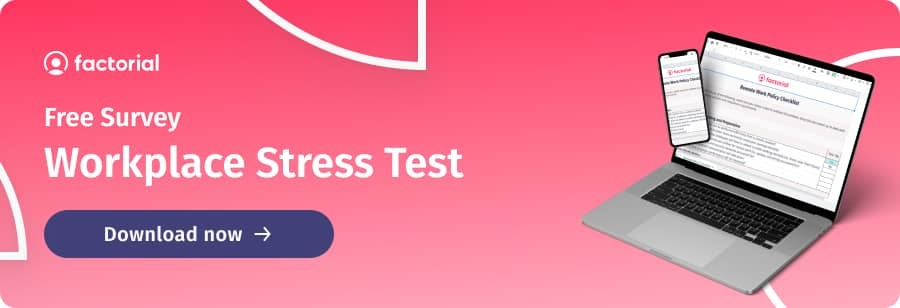According to a recent by ADP Research Institute, 68% of respondents in North America claim they feel stressed at least once a week. Yet, only 22% admit they would feel comfortable telling their manager about it. Because of this, increasing numbers of employees are taking stress leave from work.
- Do you get paid for stress leave?
- How long can you take stress leave for?
- Can you file a workers comp claim for stress?
In this post we will answer questions like this. We will also share everything you need to know about stress leave, including a few tips to help you reduce stress and anxiety levels in your company.
- What is Stress Leave from Work?
- Reasons for Stress Leave at Work: Causes of Employee Stress
- Workers Compensation & Leave: What You Need to Know
- How to Manage Stress Leave Requests
- How Managers Can Reduce Stress in the Workplace
- Stress Leave from Work: Work Accommodations for Anxiety
- Support Your Team: Manage PTO with Factorial ✅
What is Stress Leave from Work?
Stress leave, also known as stress disability leave, is a type of medical leave of absence that employees can request if they are experiencing physical and/or mental effects of stress, anxiety, or depression.
An increasingly common example of a stress leave of absence being seen by employers since the start of the pandemic is employee burnout in remote workers. Burnout occurs when employees maintain high levels of stress for too long. This might be because they are overworked, they have a tough manager with unrealistic expectations, or they don’t have the right tools and support to do their job.
Signs that an employee is experiencing stress include a drop in performance and productivity, persistent lateness, and an increase in absences. As an employer, it’s important to address any signs of stress at the first opportunity. Failure to do so can not only affect the health and wellbeing of the employee in question, but it can also have a negative impact on the overall performance of your company.
Reasons for Stress Leave at Work: Causes of Employee Stress
There are countless reasons why an employee might request stress leave. Let’s take a look at some of the most common causes:
- Workplace bullying, microaggressions or a hostile work environment. If employees don’t feel safe and secure in their working environment then it can lead to unmanageable levels of stress in the workplace. A toxic work environment can also affect the well-being and happiness of your employees.
- Burnout. If you’re employees feel overworked and that they don’t have time to meet deadlines then it can also lead to stress and burnout.
- A lack of workplace flexibility. If your company finds it difficult to adapt to changing circumstances and expectations, then the resulting stress can trickle down through every level of your company.
- Difficult relationships with managers or colleagues. For example, if a member of staff acts inappropriately, such as discussing politics in the office or asking sensitive questions about religious beliefs.
- Dysfunctional work-life balance. If an employee finds it difficult to switch off when they leave work then, over time, this can impact their work-life balance, fueling their stress levels.
- A need for increased focus on employee health and wellbeing. If companies fail to provide the right support or monitor employee satisfaction levels then mental health concerns can go unnoticed, resulting in an increase in stress leave from work.
Workers Compensation & Leave: What You Need to Know
We’ve seen what stress leave from work is, and common reasons why an employee may feel they need to request a period of stress leave. Now let’s take a look at some of the laws relating to stress leave to help you understand what your obligations are as an employer.
We will start by looking at federal obligations relating to the FMLA. We will also take a look at some of the state laws in California relating to workers comp for stress. However, it’s important to remember that stress leave laws vary by state, so you should contact your state’s department of labor if you are in any doubt.
Stress Leave Pay
According to the United States Department of Labor, the following employees are eligible for time off due to the FMLA:
Works for a covered employer (50+ employees within a 75-mile radius of the workplace);
In employment for at least 12 months; and
Has provided at least 1,250 hours of service to you during the 12-month period immediately preceding the leave.
The FMLA “entitles eligible employees of covered employers to take unpaid, job-protected leave for specified family and medical reasons”. Under the FMLA, employees who take stress leave must show that it is: (1) the result of a serious health condition, and; (2) that said condition makes the employee unable to perform the functions of his or her job.
There is no maximum time off for stress. However, under the FMLA, you are not obligated to pay employees who take a period of stress leave from work. Whether you offer time in lieu, paid leave, or unpaid time off will depend on the terms of your leave of absence policy. This policy should clearly outline all types of time off requests, including intermittent leave and sabbatical leave, amongst others.
Stress Leave California
Your obligations as an employer will also depend on the state where you are located.
For example, California Government Code §12945.2(a), also known as the California Family Rights Act, requires employers to allow employees with serious health conditions to take up to 12 weeks off in any 12-month period. This is provided they have worked at least 1,250 hours for you within the previous 12 months. The law also states that you must make a guarantee of employment upon the termination of the leave.
However, much like the FMLA, under the CFRA, you are not required to pay employees while they are out of work.
Take control with intuitive Business Management Software.👇

How to Manage Stress Leave Requests
Firstly, you need to make sure you clearly outline all processes and procedures in your time off policy. Make sure your employees understand what they need to do if they need to request time off. For example, do they know how to get stress leave approved? For that, it is important that you choose the best PTO Tracking Software.
How much notice do employees need to give you? Will you pay employees who take stress leave? What conditions must they meet in order to be eligible? How will you manage their return to work?
If you are covered by the FMLA, then your employees must send you a 30-day written notice for approval. They will also need to provide you with a medical certificate. This certificate must confirm that they suffer from a medical condition that is impairing their ability to work. You will need to approve or deny this request within 5 days of receiving it.
How Managers Can Reduce Stress in the Workplace
The best way to reduce employee stress at work is to be proactive. Create a healthy work environment and work culture founded on the values of growth and support. Establish HR best practices to increase employee satisfaction levels. Make sure your employees are taking regular breaks and using their time off allowance (if you don’t already have one, use a time off tracker to monitor leave on an individual basis). Implement measures and initiatives to make sure your workforce is happy, healthy and productive.
For example, you could share a regular Workplace Stress Survey with your employees to keep a finger on the pulse of stress levels in your company. This will help you to identify any potential issues with stress. You can also hold regular feedback sessions with employees to find out if they need support or guidance.
Stress Leave from Work: Work Accommodations for Anxiety
Finally, the best way to reduce anxiety in your organization is to nurture a culture of employee wellness.
Start by conducting a risk assessment to identify stress hazards in your workplace. The biggest causes are usually management issues, bullying and harassment, and organizational structural issues. Other factors might include overly noisy environments, uncomfortable workstations, or a culture where working long hours is rewarded.
Once you’ve identified potential causes, implement measures to improve your culture and minimize stress leave from work. The aim is to create a culture that empowers your employees with the tools they need to effectively manage everyday stressors and challenges.





